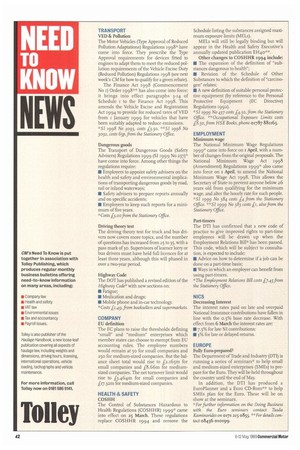NEWS
Page 44

If you've noticed an error in this article please click here to report it so we can fix it.
CM's Need To Know is put together in association with Tolley Publishing, which produces regular monthly business bulletins offering need-to-know information on many areas, including:
• Company law • Health and safety • VAT law • Environmental issues • Tax and accountancy • Payroll issues.
Tolley is also publisher of the Haulage Handbook, a new loose-leaf publication covering all aspects of haulage law, including weights and dimensions, driving hours, licensing, international operations, vehicle loading, tachographs and vehicle maintenance.
For more information, call Tolley now on 0181 686 9141.
Tolley
TRANSPORT VED & Pollution
The Motor Vehicles (Type Approval of Reduced Pollution Adaptations) Regulations 1998* have come into force. They prescribe the Type Approval requirements for devices fitted to engines to adapt them to meet the reduced pollution requirements of the Vehicle Excise Duty (Reduced Pollution) Regulations 1998 (see next week's CM for how to qualify for a green rebate).
The Finance Act 1998 (Commencement No i) Order 1998** has also come into force; it brings into effect paragraphs 3-14 of Schedule i to the Finance Act 1998. This amends the Vehicle Excise and Registration Act 1994 to provide for reduced rates of VED from i January 1999 for vehicles that have been suitably adapted to reduce emissions. *51 1998 No 3093, costs L3.50. **SI /998 No 3092, costs 65p,frorn the Stationery Office.
Dangerous goods The Transport of Dangerous Goods (Safety Advisers) Regulations 1999 (SI 1999 No 257)* have come into force. Among other things the regulations require: • Employers to appoint safety advisers on the health and safety and environmental implications of transporting dangerous goods by road, rail or inland waterways; • Safety advisers to prepare reports annually and on specific accidents; • Employers to keep such reports for a minimum of five years. *Costs D.00 from the Stationery Office.
Driving theory test
The driving theory test for truck and bus drivers now covers more topics, and the number of questions has increased from 25 to 35, with a pass mark of 3 o. Supervisors of learner lorry or bus drivers must have held full licences for at least three years, although this will phased in over a two-year period.
Highway Code
The DOT has published a revised edition ofthe Highway Code* with new sections on: III Fatigue;
• Medication and drugs;
• Mobile phone and in-car technology. *Costs D.49, from booksellers and supermarkets.
COMPANY
EU definition
The EC plans to raise the thresholds defining "small" and "medium" enterprises which member states can choose to exempt from EU accounting rules. The employee numbers would remain at 50 for small companies and 250 for medium-sized companies. But the balance sheet total would rise to i2.165m for small companies and 0.66m for mediumsized companies. The net turnover limit would rise to £3.4 64m for small companies and li7.32m for medium-sized companies.
HEALTH & SAFETY
COS HH
The Control of Substances Hazardous to Health Regulations (COSHHR) 1999* came into effect on z5 March. These regulations replace COSHHR 1994 and remove the
Schedule listing the substances assigned maximum exposure limits (MELs).
MELs will still be legally binding but will appear in the Health and Safety Executive's annually updated publication EH4o**.
Other changes to COSHHR 1994 include: • The expansion of the definition of "substances dangerous to health"; • Revision of the Schedule of Other Substances to which the definition of "carcinogen" relates; • A new definition of suitable personal protective equipment (by reference to the Personal Protective Equipment (EC Directive) Regulations 1992).
*SI No 437 costs1.1.5o, from the Stationery Office. **Occupational Exposure Limits costs i8.5o,from HSE Books, phone 01787 881165.
EMPLOYMENT
Minimum wage The National Minimum Wage Regulations 1999* came into force on I April, with a number of changes from the original proposals. The National Minimum Wage Act 1998 (Amendment) Regulations 1999* also came into force on r April, to amend the National Minimum Wage Act 1998. This allows the Secretary of State to prevent anyone below 26 years old from qualifying for the minimum wage, and alter the hourly rate for such people. *SI 1999 No 584 costs 14 f rOrn the Stationery Office. **SI 1999 No 583 costs Li, also from the Stationery Office.
Part-timers The DTI has confirmed that a new code of practice to give improved rights to part-time employees will be drawn up when the Employment Relations Bill* has been passed. This code, which will be subject to consultation, is expected to include: • Advice on how to determine if a job can be done on a part-time basis; • Ways in which an employer can benefit from using part-timers.
*The Employment Relations Bill costs £7,45 from the Stationery Office.
NICS
Decreasing Interest
The interest rates paid on late and overpaid National Insurance contributions have fallen in line with the o.5% base rate decrease. With effect from 6 March the interest rates are:
• 7.5% for late NI contributions; • 3% for late or delayed returns.
EUROPE Fully Euro-prepared?
The Department of Trade and Industry (DTI) is running a series of seminars* to help small and medium-sized enterprises (SM Es) to prepare for the Euro. They will be held throughout the country until the end of May.
In addition, the DTI has produced a EuroPlanner and a Euro CD-Rom** to help SMEs plan for the Euro. These will be on show at the seminars.
*For further information on the Doing Business with the Euro seminars contact Tuula Kaminarides on 0171 215 o855. **For details contact 08456 010199.












































































































